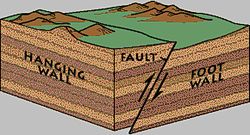Fault (geology)

A fault is a fracture, or break, in the Earth's crust (lithosphere). Some faults are active. Here, sections of rock move past each other. This sometimes makes earthquakes.
Faulting occurs when shear stress on a rock overcomes the forces which hold it together. The fracture itself is called a fault plane. When it is exposed at the Earth's surface, it may form a cliff or steep slope called a fault scarp.
The angle between the fault plane and an imaginary horizontal plane is called the dip angle of the fault. Faults may dip shallowly or steeply.
Faults are categorized into three types:
- A normal fault is one where the fault dips toward the downthrown block. Normal faults occur in rifted terranes, such as Mid-Ocean Ridges, the African Rift, and the Basin and Range Province of western North America. It is shown on geologic maps as a black line with either a block pattern on the downthrown side, or the letters U/D showing the upthrown and downthrown sides.
- A reverse fault (if steeply dipping) or thrust fault (if shallowly dipping)[1] is a fault where the fault plane dips toward the upthrown block. It is shown on the geologic map with triangular teeth pointing toward the upthrown side of the fault. Reverse and thrust faults shorten (horizontally) and thicken the crust. They are characteristic of collision origins.
- A transform (oceanic) or strike-slip (continental) fault is one where the relative motion is horizontal. The fault plane is usually vertical and can be horizontal. Famous examples of these include the San Andreas Fault of California, the Alpine Fault of New Zealand's south island, and the North Anatolian Fault in Turkey.
Fault (geology) Media
Satellite image of a fault in the Taklamakan Desert. The two colorful ridges (at bottom left and top right) used to form a single continuous line, but have been split apart by movement along the fault.
Structure of Fault Zone (Core, Damage Zone, Wall Rock) for a right lateral strike-slip faultReferenceJin-Hyuck Choi, Paul Edwards, Kyoungtae Ko, Young-Seog Kim (2016) "Definition and classification of fault damage zones: A review and a new methodological approach" Earth-Science Reviews (2016.1) Vol. 152, pp.70-87, doi :
Related pages
References
- ↑ "KGS--Petroleum: a primer for Kansas--Structure". Kansas Geological Survey. Retrieved 13 June 2010.
Books
- Brodie, Kate; Fettes, Douglas; Harte, Ben; Schmid, Rolf (29 January 2007). "3. Structural terms including fault rock terms" (PDF). Recommendations by the IUGS Subcommission on the Systematics of Metamorphic Rocks. Archived from the original (PDF) on 8 October 2013. Retrieved 4 September 2010.
{{cite journal}}: Cite journal requires|journal=(help) - Davis, George H. & Reynolds, Stephen J. (1996). "Folds". Structural geology of rocks and regions (2nd ed.). New York: John Wiley & Sons. pp. 372–424.
{{cite book}}: CS1 maint: multiple names: authors list (link) ISBN 0-471-52621-5 - Fichter, Lynn S.; Baedke, Steve J. (13 September 2000). "A primer on Appalachian structural geology". James Madison University. Archived from the original on 12 January 2010. Retrieved 19 March 2010.
- McKnight, Tom L. & Hess, Darrel (2000). "The internal processes: types of faults". Physical Geography: a landscape appreciation. Upper Saddle River, N.J.: Prentice Hall. pp. 416–7.
{{cite book}}: CS1 maint: multiple names: authors list (link) ISBN 0-13-020263-0
Other websites
- Fault Motion Animations Archived 2005-02-17 at the Wayback Machine at IRIS Consortium
- Aerial view of the San Andreas fault in the Carrizo Plain, Central California, from "How Earthquakes Happen" at USGS
- LANDSAT image of the San Andreas Fault in southern California, from "What is a Fault?" Archived 2008-04-04 at the Wayback Machine at USGS
- Photo gallery of faults Archived 2011-07-15 at the Wayback Machine at PhotoRee










